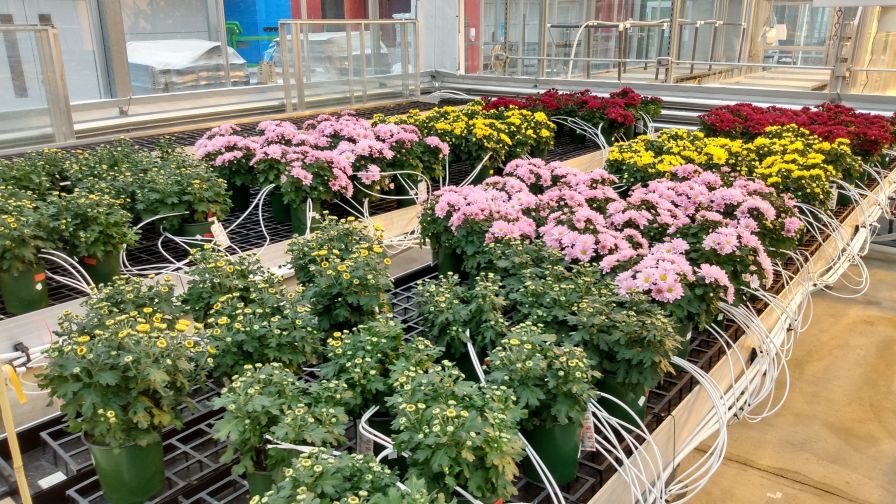Can Lowering Fertilizer Rates Help You Save Money While Maintaining Crop Quality?

Four chrysanthemum varieties growing side by side at 75ppm (left side of benches) and 250ppm of N (right side of benches) of N in a Vineland trial. Photo: Jessie deHaan
Producing high-quality plants in a cost-effective way has always been a balancing act between fertilizer, light, irrigation, and other input costs.
Unfortunately, supply chain issues caused by the pandemic slowdown, and exacerbated by the subsequent war in Ukraine, have negatively affected the global supply of fertilizer and plant nutrients. These supply issues have led to rising fertilizer prices for growers.
As input costs rise, how can growers respond and save money, while still producing first-rate products? This topic was recently addressed by Jessie deHaan, Research Technician at the Vineland Research and Innovation Centre in Ontario, in a post on OnFloriculture.com.
deHaan notes that previous studies at the University of Guelph indicated that floriculture crops often receive more fertilizer than they need. Besides the obvious economic benefits (lower input costs), lowering fertilizer input can also prevent nutrient runoff and protect lakes and waterways from increased phosphorus and nitrogen levels escaping from nearby farms. But is it possible to lower fertilizer input but still produce the same high-quality plants? If so, how low is too low?
As part of a larger project funded by Canadian Ornamental Horticulture Alliance (COHA) and American Floral Endowment (AFE) to study the effect of reducing fertilizer on plant susceptibility to thrips populations, Vineland and Ontario Ministry of Agriculture, Food and Rural Affairs researchers conducted a series of experiments on potted chrysanthemum (mum) using different fertilizer levels.
Because the effect of fertilizer reduction on potted chrysanthemum quality can be variety dependent and environmental conditions can vary between greenhouses, if you are interested in lowering fertilizer levels you will likely have to find the ideal rate for all varieties grown in your operation. This might involve putting different compartments or benches on different feed tanks. Test a small group of around 10 plants of each variety in the same year and production cycle, in an area of your greenhouse typically used for production. Test several fertilizer rates between 100 and 300ppm of N to find the optimal one that works for your greenhouse’s growing conditions while still producing beautiful plants on schedule.
The study determined that depending on your growing conditions and varieties, you may see little to no difference in plant quality by reducing fertilizer input. However, it’s important to remember that some crops or varieties may be more negatively impacted than others, so test the effect of reduced fertilizer on all crops and varieties being grown before making sweeping changes. Avoid making generalizations for all varieties if favorable results are found for one variety.
Read deHaan’s complete article here.









